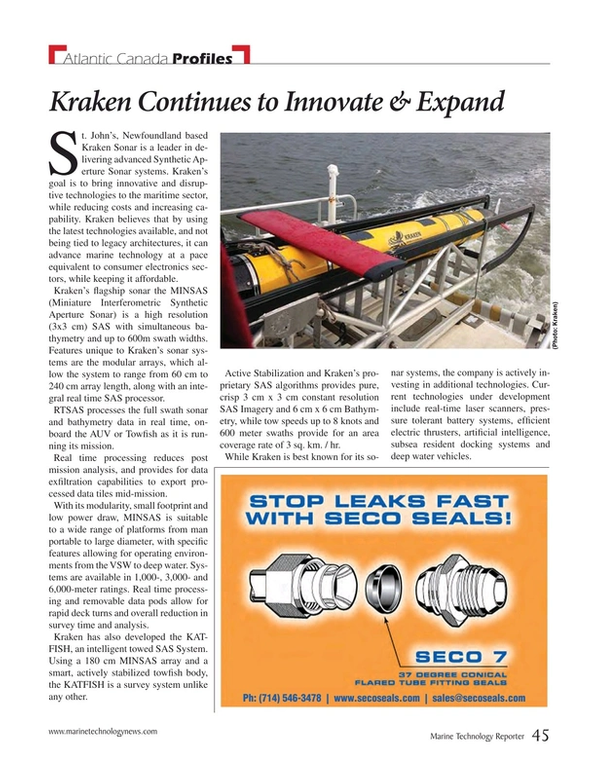
Atlantic Canada Profiles: Kraken
Marine Technology Reporter
Kraken Continues to Innovate & Expand
St. John’s, Newfoundland based Kraken Sonar is a leader in delivering advanced Synthetic Aperture Sonar systems. Kraken’s goal is to bring innovative and disruptive technologies to the maritime sector, while reducing costs and increasing capability. Kraken believes that by using the latest technologies available, and not being tied to legacy architectures, it can advance marine technology at a pace equivalent to consumer electronics sectors, while keeping it affordable.
Kraken’s flagship sonar the MINSAS (Miniature Interferometric Synthetic Aperture Sonar) is a high resolution (3x3 cm) SAS with simultaneous bathymetry and up to 600m swath widths. Features unique to Kraken’s sonar systems are the modular arrays, which allow the system to range from 60 cm to 240 cm array length, along with an integral real time SAS processor.
RTSAS processes the full swath sonar and bathymetry data in real time, onboard the AUV or Towfish as it is running its mission.
Real time processing reduces post mission analysis, and provides for data exfiltration capabilities to export processed data tiles mid-mission.
With its modularity, small footprint and low power draw, MINSAS is suitable to a wide range of platforms from man portable to large diameter, with specific features allowing for operating environments from the VSW to deep water. Systems are available in 1,000-, 3,000- and 6,000-meter ratings. Real time processing and removable data pods allow for rapid deck turns and overall reduction in survey time and analysis.
Kraken has also developed the KATFISH, an intelligent towed SAS System. Using a 180 cm MINSAS array and a smart, actively stabilized towfish body, the KATFISH is a survey system unlike any other.
Active Stabilization and Kraken’s proprietary SAS algorithms provides pure, crisp 3 cm x 3 cm constant resolution SAS Imagery and 6 cm x 6 cm Bathymetry, while tow speeds up to 8 knots and 600 meter swaths provide for an area coverage rate of 3 sq. km. / hr.
While Kraken is best known for its sonar systems, the company is actively investing in additional technologies. Current technologies under development include real-time laser scanners, pressure tolerant battery systems, efficient electric thrusters, artificial intelligence, subsea resident docking systems and deep water vehicles.
(As published in the January/February 2017 edition of Marine Technology Reporter)
Read Atlantic Canada Profiles: Kraken in Pdf, Flash or Html5 edition of January 2017 Marine Technology
Other stories from January 2017 issue
Content
- MTR Speaks with Harlan Doliner Ahead of His OINA Panel page: 10
- Tomorrow’s Defense: Unmanned Vehicles Enter the Naval Arena page: 18
- All Hands on Deck: ROVs and AUVs Aid Search for Franklin page: 22
- Atlantic Canada: Where the World’s Subsea Technology Grows page: 28
- Atlantic Canada Profiles: CNA's Wave Energy Center page: 38
- Atlantic Canada Profiles: Seaformatics Systems page: 39
- Atlantic Canada Profiles: Rutter page: 40
- Atlantic Canada Profiles: SubC Imaging page: 41
- Atlantic Canada Profiles: SULIS page: 42
- Atlantic Canada Profiles: Agile Sensor Technologies page: 44
- Atlantic Canada Profiles: Kraken page: 45


